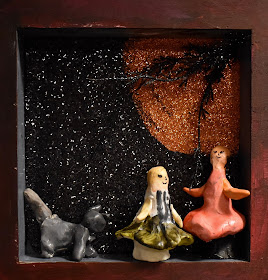For their acrylic paintings, I introduced them to some animals right here in British Columbia that are considered at risk
My hope was that by highlighting animals close to home, the issue would take on a personal meaning to them.
I brought some photos of several animals, a grizzly bear, a Vancouver Island marmot, snowshoe hare, and the spotted owl.
spotted owl, grade one
The majority of the children decided to draw and paint the spotted owl with a few kids who picked the hare, the bear and the marmot.
Vancouver Island marmot, grade one
That sounds like the title of a children's book!
Each child spent time working on a sketch first. I used this as an opportunity to have them start focusing on what they really saw in the pictures and how to record on paper the observations they were making.
spotted owl, grade one
Since for the most part this is a very young class, I began by having them find the shapes that made up the animal and then combining the shapes with line to create their drawings.
This was also an opportunity to share with them how to make conscious choices about composition and creating one that pleased the eye and drew the viewer into their works of art. Sounds like a lofty concept for young children to comprehend, but they always seem to get it.
Vancouver Island marmot, grade two
Never underestimate the mind of a child.
As the class ended, they each used a piece of carbon paper to trace their sketch onto acrylic paper and then went over the drawing once it was transferred with charcoal.
This past week, they painted. Each child had a palette of primary color plus black and white. I used this as a real opportunity for them to practice color mixing. I encouraged them to create their own colors instead of just using the blue, yellow or red someone else made.
spotted owl, grade one
Immediately the question was raised, 'Do I have to paint my animal brown?"
Which was a wonderful opportunity to discuss how many artist use color to show emotion and create mood or abstract a work for interest. I emphasized that color was an important decision they would make as artist when creating their work.
spotted owl, Kindergarten
For a couple of children, it was also a great opportunity for them to explore how to create mood with tints and tones. These two artist had made some very interesting choices with their backgrounds- one using a lot of white and the other mixing with a lot of black. As I walked by, I encouraged both of them to continue adding this element to the colors they were mixing for their owls and was so excited to see they decided to give it a try!
The black certainly leaves the viewer feeling like they have happened upon this spotted owl at night.
spotted owl, grade three
I like to share with the kids what I call, "artist secrets". There is something about calling them secrets that really captures their imagination. The first one I shared was starting with painting the background first. I also encouraged them to mix their colors directly on their paper instead of the palette.
ninja fighting snowshoe hare, grade four
I also spent some time as they painted showing them how to use brushstrokes to add interest to their works of art.
Finally as they finished their painting, I gave each child another opportunity to use the black charcoal to add any black lines they wanted. By adding charcoal while the paint is just semi-dry, it adds a very interesting look and adheres to the painting without the need of fixative.
spotted owl, grade one
spotted owl, grade one
It also gives the students more control than trying to add black line with the paintbrush.
In the end, there were some absolutely adorable works of arts. Each and every child should be incredibly proud of themselves and hopefully their artworks share with others some of the animals right here in our own part of the world who need a little extra TLC from us.
grizzly bear, grade one
















































